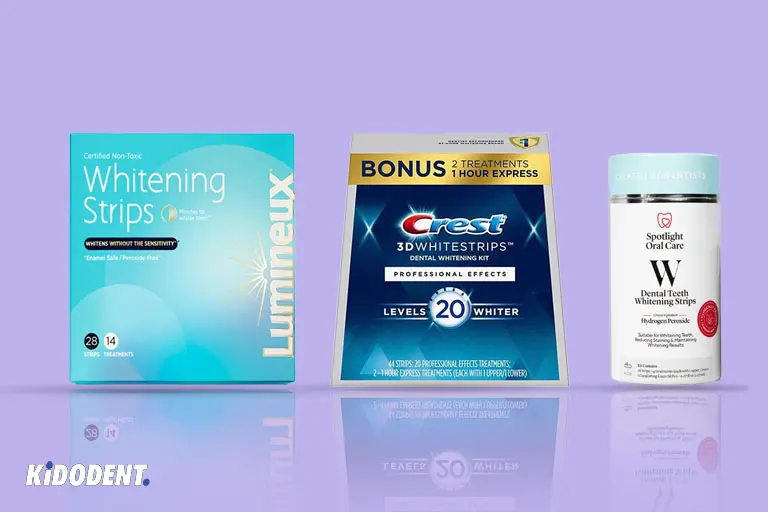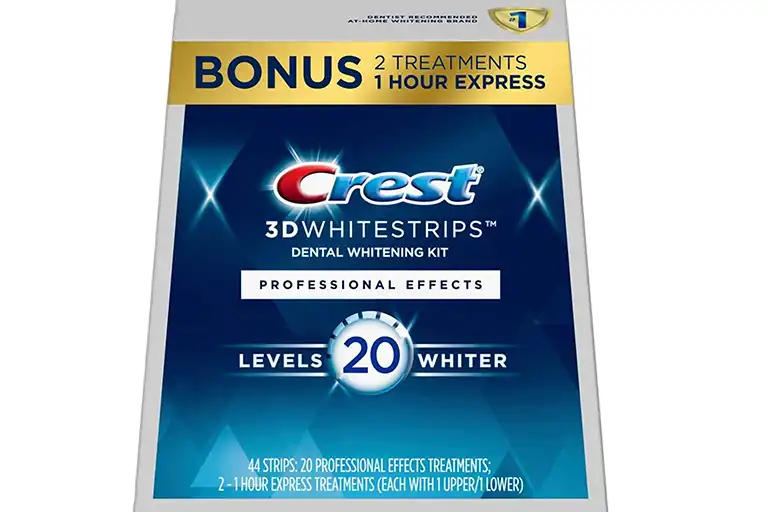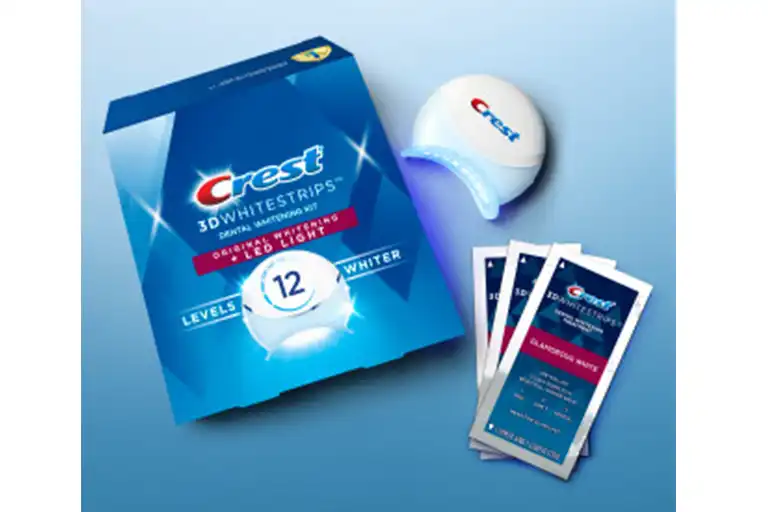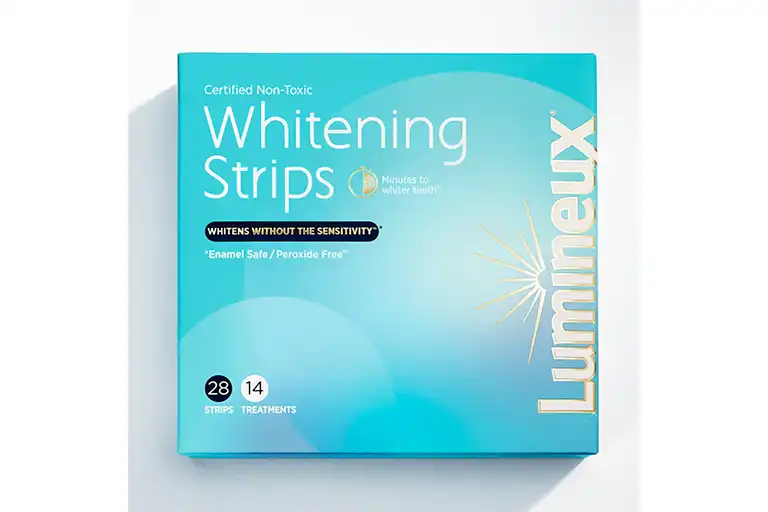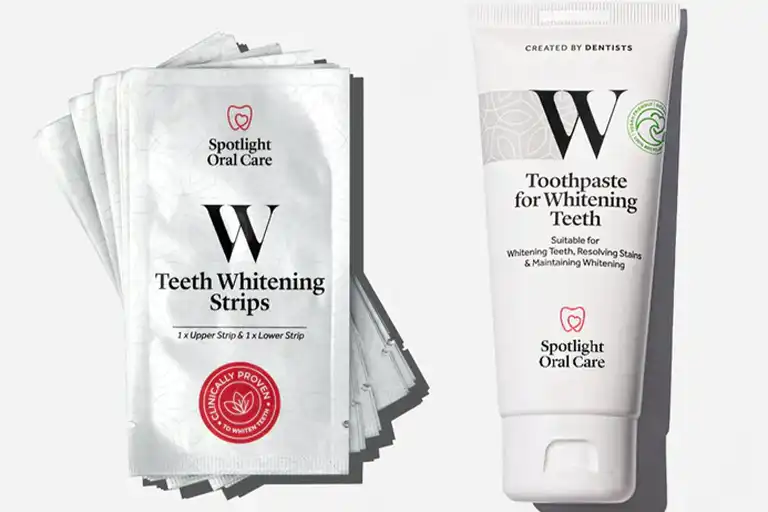There are countless tooth-whitening options to use at home for achieving brighter and whiter teeth. Teeth whitening strips are popular and simpler choices, which are inexpensive and are far from any hassles for use. Other at-home teeth-whiteners include teeth whitening pens, whitening toothpastes and finally much luxurious and highly professional kits comprise of trays and LED devices.
Although professional teeth whitening treatment by dentists (in-office bleaching) is one great way to go, over-the-counter (OTC) products are the closest way to whiten teeth effectively. OTC teeth whitening products take many forms and present as satisfying whitening results depending on stains. They are cost-effective teeth whitening alternatives, which have gained popularity.
What are teeth whitening strips and how do they work?
Teeth whitening strips are simplest and widely used at-home option to whiten teeth and brighten up your smile.
Strips are thin plastic sheets covered by whitening gel which stick to the surface of your teeth. The whitening gel is made with hydrogen peroxide or carbamide peroxide, the same agents used by dentists but in lower concentration to whiten teeth. The hydrogen or carbamide peroxide work by oxidizing mechanism to remove stain on your teeth. It means that first they break down your teeth discoloration and then produce oxygen molecule, which is the bleaching molecule, to dissolve the stain.
There are natural whitening strips for those people avoiding chemicals. Rather than peroxide, these strips use natural and plant-derived ingredients such as essential oils and botanical whitening agents.

How do you use teeth whitening strips?
Each set of teeth whitening strips comes with a number of strips for both top and bottom row of teeth. You need to peel each strip and gently press until it grips firmly on teeth. Depending on the brand, you may need to leave the strips on your teeth for a recommended period of time. Usually, the strips should be left on for 30 minutes.
This allows for longer contact between the whitening gel and the enamel (outer layer of teeth), which removes discolorations and whiten up teeth. Some people may see significant results even after just one week, but the period usually extends to two or three weeks by repeated application of whitening strips during this time scale.
Follow the instructions for each product to achieve desired whitening results for your teeth.
Pros and cons of teeth whitening strips
Whitening strips are effective options with less price compared to other OTC products. They provide an easy application with no mess and a good grip for maximum whitening to take place. If properly used, it can give a safe experience among teeth whitening options.
They come with both benefits and drawbacks:
Pros
- Easy to use and no additional work for application
- Affordable and convenient
- Faster whitening effects
- Accessible home-use option that gives the advantage of whiter teeth and smile from the comfort of your home
- Effective and visible results due to longer contact with teeth and professional whitening agents used (hydrogen peroxide or other whitening formula)
Cons
- Gum irritations when the gel come into contact with gums and soft tissues
- Higher possibility of teeth sensitivity issues
- Can damage enamel if overused or not used properly
- Uneven and irregular whitened teeth when not used as directed or not fit well
Common ingredients found in whitening strips
Each teeth whitening strips can have different formula specifically made to whiten teeth and hence offer varied results.
- Hydrogen and carbamide peroxide which are the bleaching agents
- Glycerin, propylene glycol or PEG (polymerization ethylene lycol) for thickening the gel and making good contact with your teeth
- Sugar-free sweeteners such as xylitol, sorbitol, saccharin, and mannitol. These non-sugar sweeteners not only improve the taste but have other benefits. For example, xylitol helps break down stains and plaque while it has anticaries properties. Sorbitol and mannitol are also non-toxic humectants, meaning they keep the whitening gel hydrated and flexible.
- Adhesive agents such as carbomer and PVP (polyvinylpyrrolidone) contribute to bonding of the gel to the surface of teeth.
We have gathered top picks of whitening strips in the list below based on our research and the level of efficacy that these products can provide.
Here are the 6 best teeth whitening strips
- Crest 3D White Professional Effects Whitestrips
-

Best Overall
Crest 3D Whitestrips® are prominent for best whitening efficacy among the strips. Crest’s products really shine compared to the other widely-used and high-quality oral care brands. Thus, for cosmetic benefits, they make use of their longtime experience in over-the-counter whitening products. Their new Crest 3D White Professional effects Whitestrips is specifically formulated with hydrogen peroxide for a professional whitening experience.
The package includes enough strips for 40 treatments. When properly used, the product has shown that it brings about ultimate whitening while keeping teeth safe. Use 30 minutes daily for erasing years of teeth stains and achieving brighter and whiter teeth.
The no-slip strips offer a good grip that ensures a great exposure of teeth to the whitening gel and no coming-offs or slippage.
Cost: $45
- Crest 3D Whitestrips Original Teeth Whitening Kit (Glamorous with LED light)
-

Best Splurge Whitening Strips with LED Light
A little beyond the budget but with handful of advantages. In the Crest 3D Whitestrips Original Teeth Whitening Kit, the high-rated and dentist-approved Crest 3D Whitestrips Glamorous White is combined with an LED light for a boosting whitening effect. It contains hydrogen peroxide to work out effectively in removing stains. The product has ADA Seal of Acceptance, which shows it is approved by American Dental Association and therefore safe to use.
The LED light offers less time in achieving perfect whiteness for teeth while reducing sensitivity. The package covers 14 treatments that gives a longtime of visibly whiter teeth.
By using this all-in-one product 30 minutes daily, you can expect noticeable improvements in teeth and make the most of what you can get from a whitening strip.
Cost: $70
- Hismile PAP+ Whitening Strips™
-

Best for Teeth Sensitivity
Unlike most strips which use hydrogen peroxide to whiten teeth, hismile® whitening strips whiten teeth using a clinically-proven and specially formulated whitening system called PAP (stands for phthalimidoperoxycaproic Acid).
The ingredients work the same as the bleaching mechanism of peroxide-based agents which break down the stain and tooth discoloration through oxidization. Except for that, in the PAP there is no teeth sensitivity.
Other ingredients found in this product include:
- Potassium citrate: a desensitizing agent to reduce the pre-existing teeth sensitivity through dental sensory nerve
- Hydroxyapatite: a remineralising agent to rebuild lost minerals in teeth
The enamel-safe whitening strips by hismilePAP promise to remove stains and present an instant whiter teeth ASAP. It does require 30 minutes wearing. Also, there is a 14-treatment supply in the package.
Cost: between $16 to $30
- Lumineux Oral Essentials Whitening Strips
-

Best Natural for Sensitive Teeth
If you are seeking natural whitening strips, Lumineux strips can’t be missed. This peroxide-free product uses natural brighteners such as coconut oil, lemon peel oil, aloe vera, sage oil and essential oils for an ideal whitening experience. A great option for those people who want to avoid gum irritations and teeth sensitivity thanks to its naturally derived ingredients. Plus, the Lumieux’ dead sea salt ingredient makes the strip an enamel-safe option which comes with beneficial minerals like potassium, calcium and magnesium.
Feel comfortable and enjoy the naturally-flavored taste of Lumineux whitening strips since the product is enriched with mint, basil, and clove oils to freshen breath. It is free of artificial flavor, color and any toxic ingredients.
Use daily for 30 minutes and 7 consecutive days to see the brilliant results. The package comes with enough strips for 2-week supply if used as directed.
Cost: $44
- Zimba Teeth Whitening Strips
-

Best Taste and Flavor
Zimba Teeth Whitening Strips is known for best naturally derived flavors for a great taste experience. The brand is made with gentler form of active hydrogen peroxide ingredient in order to remove stains as effectively and deeply with less chance of sensitivity.
The brand is marketed in around 10 natural flavors such as mint, coconut, wintergreen, cinnamon, and strawberry, which makes teeth whitening pleasing for any taste preferences. Plus, Zimba’s whitening strips use essential oils like menthol in their ingredients, which not only provide a natural taste but acts as an antibacterial agent to help remove plaque and staining on teeth.
As usual, the product requires 30 minutes daily application. It comes with 28 strips for both top and bottom teeth, enough for two weeks.
Cost: $24.99
- Spotlight Oral Care Teeth Whitening Strips
-

Best All-In-One Whitening Strips
Formulated with 0.01 percent hydrogen peroxide, Spotlight whitening strips will break down teeth stains and help to dissolve discoloration effectively and comfortably. It is vegan-friendly and toxin-free favored by those avoiding extra chemicals.
Although Spotlight whitening strips needs 1 hour to stay on teeth, you could see significantly whiter and brighter teeth in as little as 14 days in this professional whitening kit, according to the company.
This high-rated and dentist-made whitening strip comes as one of the best bundles you can get your hands on. Beside the 28 whitening strips, the package includes whitening toothpaste or it may have Comforting Gum Oil to reduce any potential irritations and sensitivity.
Spotlight also offers their best-selling Whitening Essentials Bundle® in a complete kit alongside with strips as a bundle. It includes whitening toothpaste, teeth whitening mouthwash, teeth whitening pen and even dental floss (coated with hydrogen peroxide) that is €72.90 in price.
Cost: $35
Are whitening strips safe?
As long as you keep to recommended use, you will have no problems. Teeth sensitivity is a common temporary side effect. It occurs because of exposed underlying layer of teeth, called dentin. Teeth sensitivity is mild and goes away once you stop using the product.
Peroxide-based whitening products work by dissolving the satins through oxidization and do not damage enamel when properly used. Therefore, if used correctly, hydrogen peroxide or carbamide peroxide are safe to use and have not shown to be a risk for enamel.
Keep in mind that hydrogen peroxide and carbamide peroxide make up the main bleaching agents in professional teeth whitening by dentists. Dentists, but, use higher dosage of peroxide to whiten teeth, which increases the chance of sensitivity in teeth.
One issue with hydrogen peroxide is gum irritation and it happens when the whitening gel is exposed to soft tissues like your gums during treatment. You can prevent the gel from coming into contact with gums if you apply the strips based on the product’s instruction. The gum irritation happens because peroxide is also an antiseptic to treat gum diseases and prevent bacterial activity.
Other teeth whitening options vs teeth whitening strips
In-office professional teeth whitening
It is done by dentists in one or more sessions. The session can take 30 minutes to 1 hour. Depending on whether you have superficial stains or deep stains (e,g tetracycline stains), you may require more or less in-office treatments. Also, your dentist may prescribe home sessions, too.
They use high levels of hydrogen peroxide (30% to 35%) with silica to make a powerful whitening gel. They may try a number of techniques including, adding fluoride or calcium for the purpose of remineralization of enamel, which strengthen enamel while whitening your teeth.
For maximum whitening and speed, dentists can use heat and light techniques. You may have seen the blue light which is held against teeth to break up the gel in whitening process. Some at-home whitening kits also come with these LED devices.
Cost: $500 to $1000
Whitening tray with gels and LED kit
Whitening gels accompanied by LED kit and trays are the most effective at-home teeth whitening kit and the closest to professional in-office treatment. The kit includes custom trays (you wear over your teeth), the whitening gel (in pens or serums which you respectively apply on teeth or squeeze into the tray) and finally the LED device to speed up the process and change the temperatures.
Cost: $70 to $200
Whitening pens
Like strips, whitening teeth with pens are best options for on-the-go treatment. The pens are light and can be easily carried around. They include whitening gel form either hydrogen peroxide or carbamide peroxide. You simply apply the pen on the surface of teeth or location of tooth you want whitened. It takes seconds to apply and you can use the pen twice daily for the period of 2 or 3 weeks or until the desired whitening is achieved.
Cost: $20 to $50
Whitening toothpastes
To remove stains and brighten your smile, toothpaste is another familiar alternative. They are handy and require normal daily brushing for 2 minutes.
As part of the active ingredients, the whitening toothpaste can include anticavity, antiplaque, and antimicrobial agents to fight cavities and plaque buildups. Whitening toothpastes are different from ordinary toothpaste in terms of other ingredients that make up the whitening formula.
Toothpastes labelled as whitening can have peroxides (carbamide or hydrogen) as bleaching agents like other OTC products but in lower dosage. They may have additional levels of abrasives to get deeper in teeth for better stain removal process. Although the whitening is not as fast and visible in short time, toothpastes whiten teeth gradually and over time.
Cost: $3 to $20
Whitening mouthwashes
Typically, whitening mouthwashes contain the lowest amount of peroxide bleaching agents among other OTC products. Therefore, it can be an option for those with teeth sensitivity issues. On the other hand, you can’t expect dramatic results compared to other whitening options. Mouthwashes are meant to kill bacteria and improve bad taste, which is a great benefit. Some products may cause burn and sensitivity feeling in mouth, too.
Cost: $3 to $15
